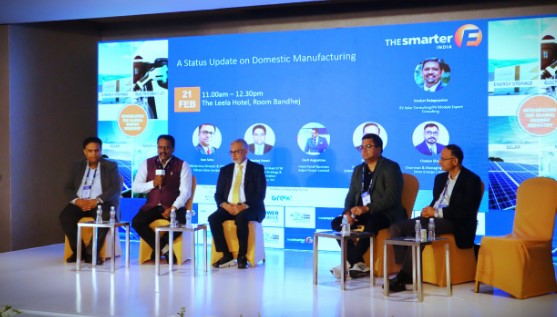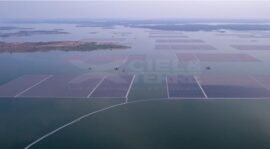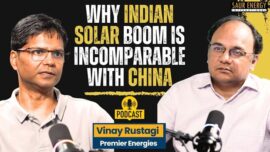Highlights :
- India’s top solar manufacturers stressed on the need for policy stability and clarity, to truly realise the potential of solar manufacturing

At the SmarterE India, (formerly Intersolar event) event in Ahmedabad, it was a day for India’s solar manufacturers to make their case at a time when far too many policy influencers seem confused about the future. The conference for the event, in a session titled ‘ A Status Update On Domestic Manufacturing” on day 2(Feb 21), brought together some of India’s biggest solar manufacturers on stage.
So we had Ivan Saha, Whole time Director & CEO Vikram Solar Limited, Cecil Augustine, Head Retail Business, Adani Power Limited, Rohit Dhar, Chief Operating Officer, EMMVEE Photovoltaic Power, Chetan Shah, Chairman & Managing Director, Solex Energy Limited and Pankaj Vassal, President & Business Head GTM Marketing Business Strategy & Transformation Digital Transformation at Waaree Energies Ltd.
The session was moderated ably by Venkat Rajgopalan, RV Solar Consulting/ PV Module Expert.
Venkat quizzed the panelists on key issues ranging from ALMM, the ideal solar module size, future technologies, skills shortage in India, India’s place in the global market and more, drawing a range of responses from the panelists.
Thus, Emvee’s Rohit Dhar was at pains to point out that above all, the country needed policies that were long term and consistent, especially when speaking in the context of ALMM, a view endorsed by every panelist. Chetan Shah of Solex even stressed that actual benefits from ALMM, first introduced in 2019 are still awaited for most Indian manufacturers, thanks to the Covid disruptions that followed immediately, and the successive tinkering and flip flops the industry had seen since with exemptions etc.
Cecil Augustine pointed out that for all the talk of high domestic nameplate capacity worth 40 GW and more, actual operational capacity in India for cell manufacturing is at barely 6 GW currently, even as module manufacturing capacity nudges 26 GW. Drawing an analogy with the rapid growth India has seen in telecom, he stressed that stable, forward looking policies are a must for healthy growth of the sector.
Waaree’s Pankaj Vassal stressed on looking at the global picture, where India had an opportunity to seek a significant share of the market with proper planning for domestic manufacturing. ‘Technology leadership beckons for India’, if we take the right decisions and steps now, he stressed.
Vikram Solar’s Ivan Saha, while making a point about the presence of just two Indian manufacturer’s (Adani and Vikram) in BNEF’s Tier 1 list of manufacturers globally, with a capacity share of under 2% in global manufacturing, stressed that India can, and should do much better. He cited the example of handsets, where noone expected India to make the strides it has in manufacturing, with a pathway to further value addition still very much doable and ahead for the industry. He stressed on the need to develop an appetite to invest in R&D for firms here, to support a strong ecosystem as well as prepare better for the future as China did.
Panelists agreed on the emergence and dominance of the Topcon modules in the market for now, pointing out that most Indian manufacturers had read the writing on the wall and adapted accordingly. Saha stressed on the need to look ahead and be prepared for the next change, be it IBC, HJT or Tandem cells and more.
On Module Sizes, while the consensus view was that the M10 size is ideal for India and beyond, eventually markets like the US, or Chinese majors would provide direction on future sizes, all agreed.
Panelists also stressed on the need to allow domestic manufacturing space to grow for the sheer potential it offers for jobs in manufacturing and beyond. With a 32 GW target on PM KUSUM, a 30 GW plus prospect from the PM Surya Muft Bijli Yojana and more, millions of much needed jobs could be created with the right policy direction, all felt. On the immediate future, panelists remained optimistic about prospects, thanks the above mentioned schemes as well as the momentum seen in utility and commercial markets.
Panelists also stressed on the need to support and develop a manufacturing ecosystem for other key BOS (Balance of Systems) components of a solar plant, from laminators, to stringer machine makers to solar glass and more. Emvee’s Dhar stressed on the need for manufacturers themselves to seek sourcing from such domestic makers, to walk the talk.






























